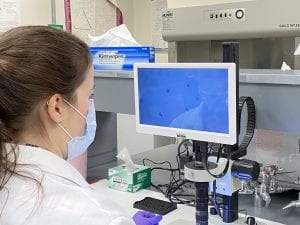Biological Evidence Mission Statement
Our goals are to assist the national and international forensic science community by (1) conducting pure and applied research in forensic molecular genetics/biochemistry in order to contribute to the body of forensic science knowledge; (2) validating methods and technologies to facilitate technology transfer, and (3) providing operational support by supporting on-line databases of Y-STR markers and mass fatality initiatives (4) providing rigorous educational programs such as BS, MS in Forensic Science and PhD in Bimolecular Science.
Research Projects Publications & Presentations Biological Evidence Links Personnel-Biological Evidence Contact UsForensic Biology
What is Forensic Biology?
Forensic Biology is the application of Biology (Genetics, Biochemistry and Molecular Biology) applied to the solution of certain problems that arise in connection with the administration of justice. It is science exercised in the service of the law. More practically it is the study of blood and other physiological material as it relates to establishing a fact that may be at issue in a medical legal investigation.
Situations in which forensic biological evidence may be important
- Crimes against a person
– homicide
– assault
– rape/ or other sexual assaults
– criminal paternity
– terrorism - Crimes against property
– burglary - Mass Fatality Incidents
- Motor Vehicle Incidents
- Paternity/Kinship
Biological Evidence Transfer
Every crime takes place at a certain time at a certain place or places (the scene(s)) and involves a victim and the person or persons committing the crime (perpetrator(s)). The perpetrator may or may not use a weapon. Depending upon the case circumstances, biological material is transferred between the scene, the victim, the perpetrator and the weapon. Evidence transfer is illustrated below with the most common direction of transfer indicated by the arrows.

Types of Biological Evidence
- Blood
- Semen
- Saliva (e.g. Cigarettes)
- Vaginal Secretions
- Fecal Material
- Hair
- Urine
- Bone

Meaning of DNA Match
The basic theory behind DNA testing is that no two individuals would be expected to posses the same so-called nuclear DNA type (except identical twins). Typically, a ‘nuclear’ DNA match between a crime scene sample and an individual would be an exceedingly rare event if the individual was not the true source of the crime scene sample. This high degree of individual specificity is often indicated in scientific reports by a statistical evaluation of the rarity of the observed genetic profile. An example of conclusions provided to the Courts when a DNA match is observed would be as follows:
Approximately 1 person in every 5 trillion chosen at random from the population would be expected to possess the same DNA genotype as that found in the questioned sample’. Since 5 trillion is much more than the population of the World (and so one couldn’t have 5 trillion people to compare) an alternative conclusion (based upon the same data) may be adduced. ‘The DNA results are 5 trillion times more likely if the questioned sample originated from the suspect than if it had originated from a randomly chosen unrelated individual from the population’.
